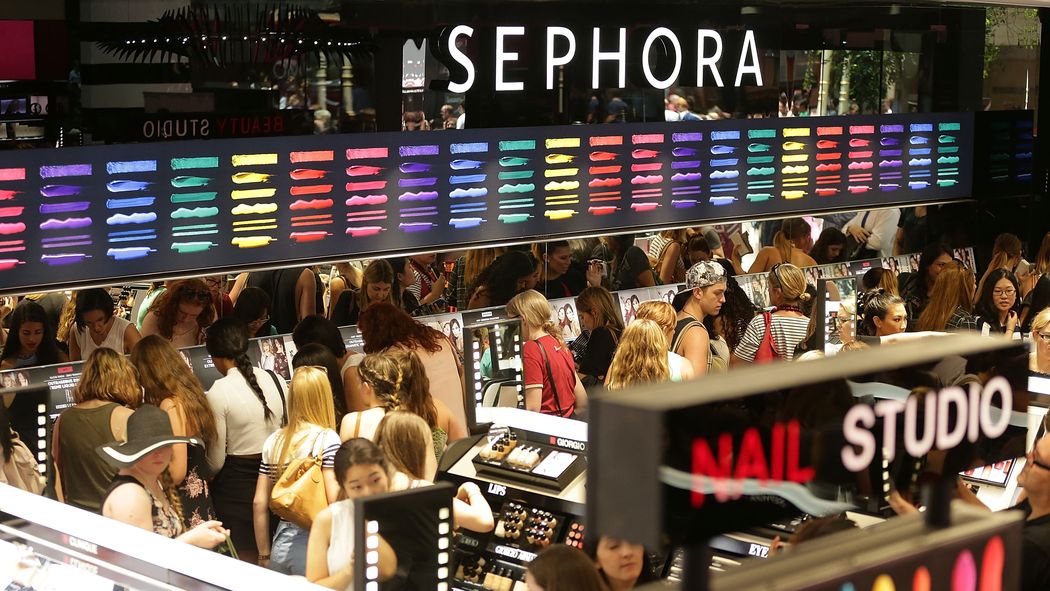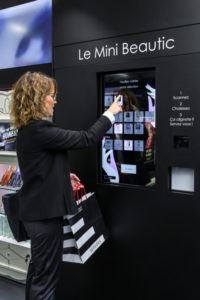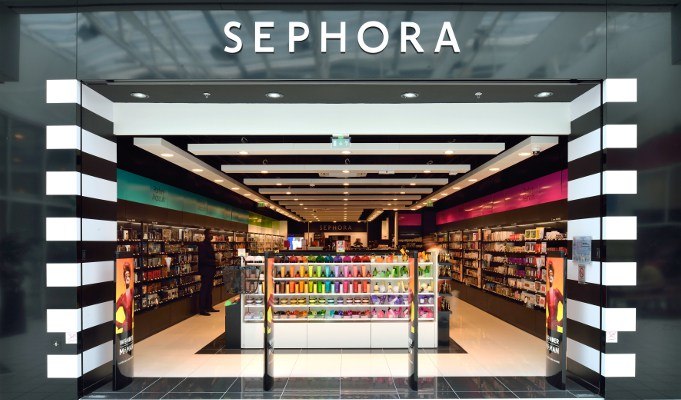Sephora: Who wants a virtual makeover?
Sephora’s new tech initiatives are revolutionizing the beauty industry by virtually transforming users’ personalized shopping experiences.
We’ve all used Snapchat and tried their bizarre filters that make us look like puppies. Now imagine, ladies, wouldn’t it be great if we could have filters that show us what different lipstick shades look on us? Swipe right, bright pink lipstick by Chanel. Swipe right again, nude lips by NARS. Well, Sephora has done just that. And in doing so, it is slowly revolutionizing—or should I say, technologizing—the beauty cosmetics industry.
Sephora’s Customer Experience-Centric Business Model
Founded in the 1960s in Paris, Sephora is a beauty business that has come to globally dominate an industry traditionally controlled by department stores. Its secret sauce was its “self-service” concept: consumers could touch and test its products, without the meditation of a salesperson, hence transforming its stores into interactive, fun spaces.[1] This model underscored Sephora’s fundamental value proposition of providing customers with unique, interactive and personalized beauty shopping experiences.[2] The wild success of this model has led to the development of 1,900 locations in 30 countries.[7]

Sixty years later, instead of shying away from technology, Sephora has embraced it. Technology could be used to support Sephora’s value proposition by using bold innovations to further enhance the personalized beauty experience. CEO Christopher de Lapuente remarked, “Innovation definitely figures at the very heart of Sephora. We constantly challenge ourselves to discover new and better ways to make the customer experience even more inspiring.”[3]
Sephora’s Operating Model: Delivering a ‘Technologized’ Beauty Experience
Sephora is now using technology to take their value proposition (and entire business) to a new level. Here are several tech initiatives Sephora has implemented in its operating model that further allow customers to have the unique experience of testing luxury beauty products:
- Sephora Mobile: While a mobile app isn’t earth-shattering, Sephora’s is the gateway for its consumers in a digital world to access its shop from the tips of their fingers, anywhere in the world at any time. The mobile app has an easy interface that enables users to shop, purchase items, and interact with others through the Beauty Board, a platform that allows customers to share beauty tips by uploading personal photos and identifying the products they used.

- Sephora Virtual Artist: Remember that lipstick filter we described above? This is it. Thank you, Sephora for creating a way for us girls to play with make-up without the removal mess. Through the mobile app, consumers can access Sephora Virtual Artist, where they can virtually test out over 1,000 lip shades and 90 false lashes by using the camera on their phone and swiping through the various filters. Once a customer finds the shades they like, they can purchase the product hassle- and toilette-free. It gets better. Customers can also use a feature called Compare Me, which allows them to see up to four different looks on one screen, and Shake It Up, which randomly selects looks for you each time you shake your phone. Don’t worry, these features are indeed accessible on your desktop.

- Sephora Virtual Tutorials: The fun doesn’t stop with just lipstick shades. Sephora has also created Virtual Tutorials where you can use your camera to see step-by-step instructions for various make-up looks (“smokey eyes” or “contouring”) layered on your face.[4] On your phone screen, the products needed are listed and then applied on your face at each step. [5] Goodbye Youtube tutorials and make-up professionals. Virtual make-overs are now in.

- Flash Connected Stores: If you are one of those people who prefers the physical shopping experience, don’t worry the tech innovations continue there. Sephora has introduced a Flash store concept that merges physical and digital shopping experiences. In a Flash store (so far, one boutique has opened in Paris), a small selection of its best-seller products is showcased alongside a digital catalogue of more than 14,000 products from over 150 brands accessible through massive touch-screens posted on the walls and counters. These digital products can be paid for in store along with the physical products, and picked up the very next day from the store or delivered to your home.[6]

Sephora is undeniably transforming the way of beauty business in today’s tech world. A few more ideas that Sephora could consider to further its value prop could be a Sephora type of virtual Birch Box, where customers can curate a box of cosmetics online. The customer will receive the goods within days and will only be charged with the products they keep. Additionally, to build out Virtual Artist, users could upload photos, and bots using visualization algorithms could suggest products for the user by delivering images of the user with a tech-application of the product. These would both further enhance and make easier the personalized shopping experience.
So, who wants to try a virtual make-over?
Word Count: 798
[1] LVMH, “Viva Technology: innovation at the heart of Sephora,” https://www.lvmh.com/news-documents/news/viva-technology-innovation-at-the-heart-of-sephora, accessed November 2016.
[2] “A Digital Customer Experience Case Study: Sephora’s Supremacy,” http://www.mcorpcx.com/a-digital-customer-experience-case-study-sephoras-supremacy, accessed November 2016.
[3] LVMH, “Viva Technology: innovation at the heart of Sephora,” https://www.lvmh.com/news-documents/news/viva-technology-innovation-at-the-heart-of-sephora, accessed November 2016.
[4] Racked, “Sephora’s New Lipstick Try-on App Works Creepily Well,” http://www.racked.com/2016/2/3/10905650/sephora-app-virtual-artist, accessed November 2016.
[5] InStyle, “Sephora Just Revamped the Virtual Makeover with a False Lash Try-On Tool, http://www.instyle.com/beauty/sephora-virtual-artist-launch, accessed on November 2016.
[6] Instyle, “Sephora is changing the way you shop in-store and online,” http://www.instyle.com/news/sephora-flash-connected-store, accessed November 2016.
[7] Sephora, “About Us,” http://www.sephora.com/about-us, accessed November 2016.




Nice post! Good for Sephora for both leading the in-person interactive experience 60 years ago and now the digital interactive experience.
Another option Sephora may want to consider is allowing users to upload photos onto the mobile app and then recommending products to recreate that look. This reminds me of the Mink makeup case from marketing, where customers can take photos and then use that to print 3D makeup. However, unlike Mink, Sephora’s approach of using its own catalogue of makeup requires less upfront cost in buying a 3D printer and less friction in changing how customers obtain their makeup.
Thanks for writing this – I am downloading the app right now to test it.
Additionally, I would like to share another anecdote of how Sephora is managing to mix the “real world” experience with the digital one.
Buying perfumes online has always been a challenge given that you cannot smell them beforehand. To solve that Sephora offers the purchase of a “TBD” perfume. With that, customers receive approx. 20 samples at home to test them before actually selecting which perfume they want.
Going forward, what I would like to have online is a feature to actually help me select my foundation color without having to go in-store to try.
I want to try it!
I hate buying makeup and honestly, have only been an a Sephora once or twice since I am a big believer in drug store makeup being just as good. That said, I understand the Sephora value prop and understand why the company has seen tremendous success. As an established brand, it is even more admirable that Sephora continues to take risks and embrace technology. Considering the physical products themselves.. I wonder if there a “smart” product idea out there in this space. Say a brush that indicates when it needs to be cleaned? It may seem far-retched, but as this kind of technology becomes cheaper and “smart” products become the norm, customers may expect further innovation from Sephora.
This is awesome! I can’t wait to download the app and try it out. I wonder what effect this will have on Sephora’s need for retail associates. I’m sure some customers still find value in speaking to an associate when they purchase makeup. However, Sephora may be able to significantly reduce their overhead costs if more people make use of this app.
I agree with others who have said that Sephora has the potential to use this app to help recommend products to customers. Women of color in particular often find it challenging to purchase foundations since there are rarely colors that are a perfect match. I think it would be great if this app could allow customers to upload pictures of themselves and then it could recommend foundation brands / colors that would be well suited for the customer.
This is great – such awesome innovations. I agree with all the comments above – particularly Brittany’s and YM’s! As someone whose skin is extremely pale, I would also love an application that scans my skin color and matches it across all the possible foundation options within Sephora’s product assortment. To the point on perfume, it would be incredibly helpful to receive a small sample of a couple of foundation options, after the matching technology was applied, to try first before making an expensive purchase. One additional suggestion for innovation is a batching system that allows Sephora’s personalization logic to dynamically select products that fit a customer’s purchasing history, and temporarily batch them together into a discounted set based on margin considerations or current manufacturer discounts, etc.
Sephora is definitely an innovator in the makeup space, and I look forward to continuing to watch their evolution.
What an interesting development in Sephora’s goal to be “unique, interactive, and personalized.” I love this concept and I think that is something that Millennials and Gen Z will get on board with pretty seamlessly. One problem that I struggle when I’m in Sephora is how makeup looks in the light of the store, vs. how it looks when I get home. If I was able to test how make up looked in different light, through my phone, this could be a major breakthrough! I too suffer from the same extreme paleness that Caroline mentioned, so increasing this application to the face makeup segment would be great for users. From my time working at Revlon, skin tone matching was a problem for many consumers, so having an app that could suggest color tones and shades for consumers would be a major breakthrough.
I am a loyal Sephora customer so I was excited to read this! I already use their shopping app but was unaware of the virtual artist and virtual tutorials that they offer – will definitely have to try both!
I think it’s great that beauty companies are embracing technology and I’m excited to see how this will evolve. According to the Euromonitor Beauty Survey, “…the apps landscape is moving toward more personalized, connected and interactive features, measuring results and efficacy.” As an example, OKU skin care coach -launched in 2015- is a digital consultation tool that monitors skin health and provides personalized recommendations, routines and products. Will be monitoring this landscape closley!
Source: http://www.quirks.com/articles/digital-initiatives-key-areas-beauty-companies-need-to-target-in-2016